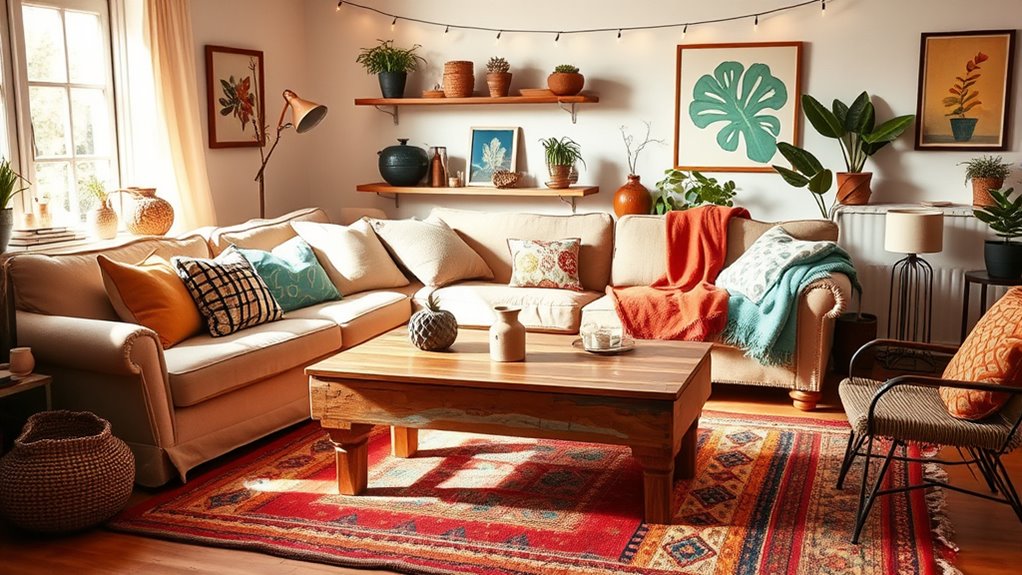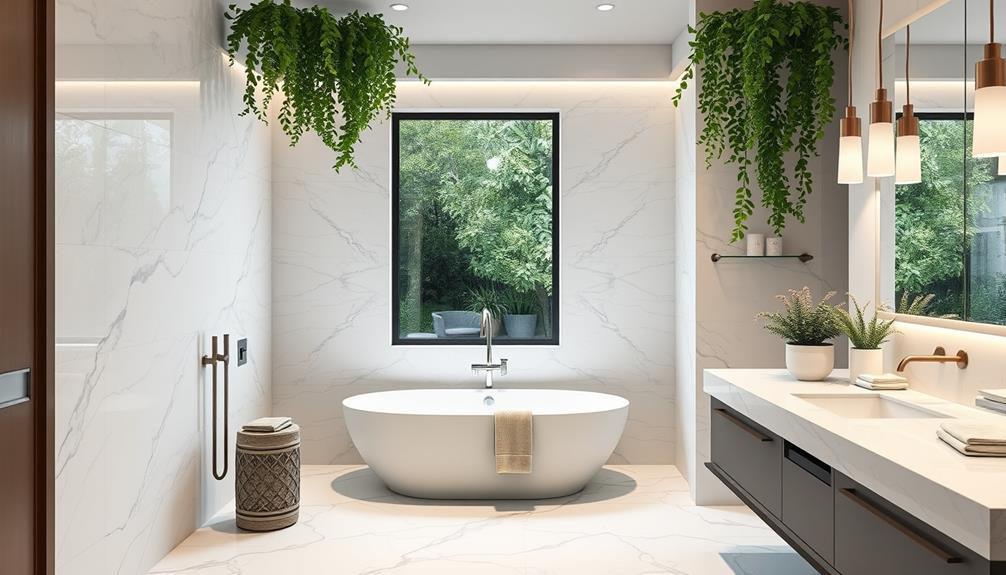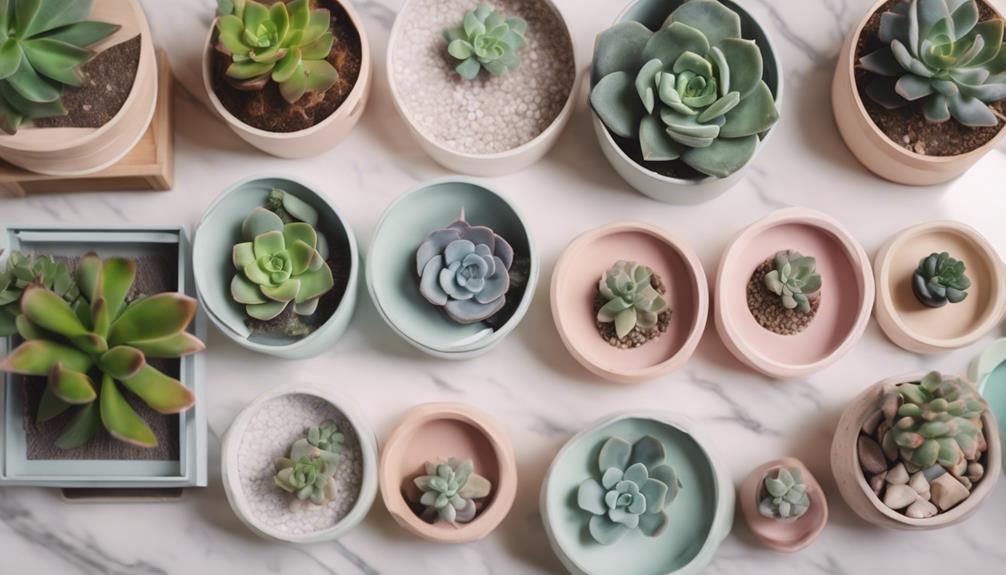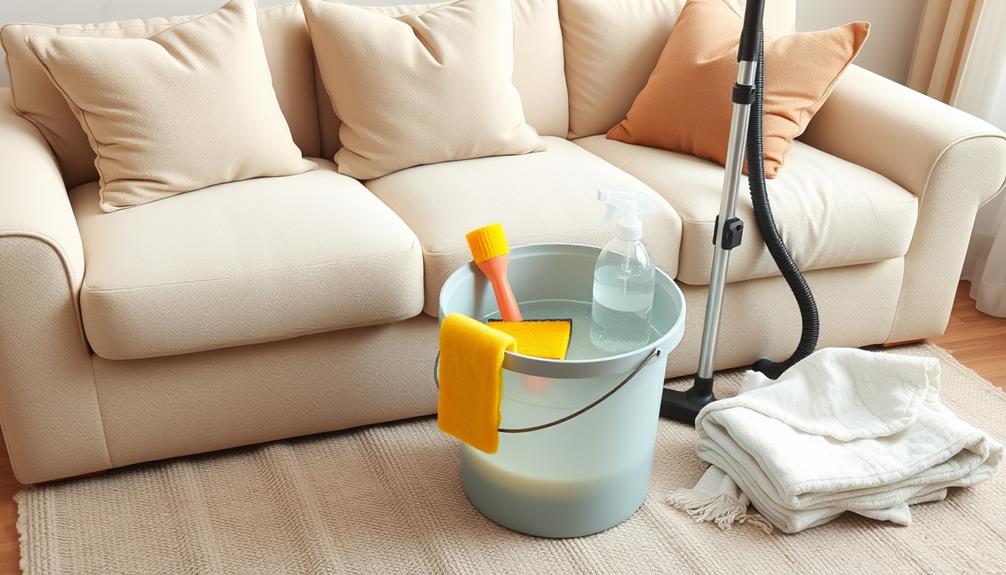To style your home for less, focus on planning your space first and set a realistic budget. Prioritize key pieces like a sofa or dining table, then get creative with repurposing, DIY projects, and shopping at thrift stores or sales. Use paint to refresh furniture and create accent walls. Add personal touches with accessories and lighting to make your space cozy and unique. Keep all elements cohesive with a thoughtful color scheme. For more savvy tips, discover how to maximize your budget effectively.
Key Takeaways
- Plan your decor carefully, set a budget, and focus on essential, versatile pieces to avoid overspending.
- Repurpose and upcycle existing furniture and decor to refresh your space affordably.
- Shop at thrift stores, clearance sales, and flea markets for unique, budget-friendly finds.
- Use paint and DIY projects to transform and personalize your home cost-effectively.
- Focus on strategic lighting and key decor elements to create a stylish look without high costs.
Prioritize Key Pieces for Impact
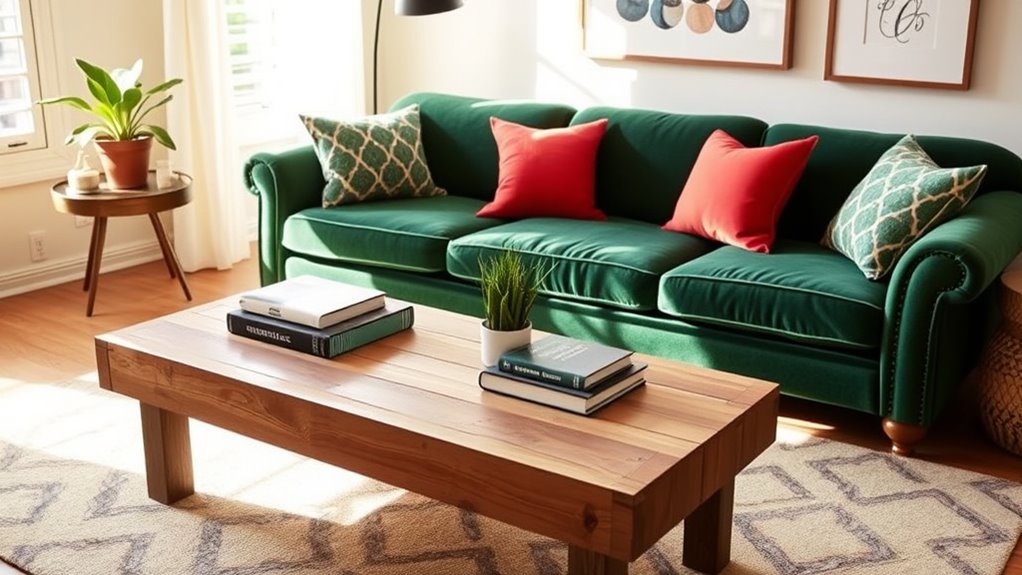
When working with a limited budget, focusing on a few key pieces that make a big impact can transform your space without overspending. Choose versatile furniture like a statement sofa or a standout dining table that anchors the room. Invest in quality pieces that will last and serve as focal points, rather than spreading your budget thin on numerous lesser items. Think about eye-catching lighting fixtures or a bold piece of artwork that draws attention. These elements set the tone and style of your home, so prioritize items that reflect your personality and can be styled easily. Remember, a well-chosen centerpiece can elevate the entire room, making it look polished without requiring a full overhaul. Incorporating statement lighting can significantly enhance the ambiance and style of your space on a budget. Additionally, understanding ethical hacking principles can help you protect your online presence while you focus on beautifying your home. Developing an eye for creative practice can inspire innovative decorating ideas that maximize your limited resources. Furthermore, researching entertainment and parks hours can help you plan visits to nearby attractions during off-peak times, allowing you to enjoy leisure activities without breaking your budget.
Repurpose and Upcycle Existing Items
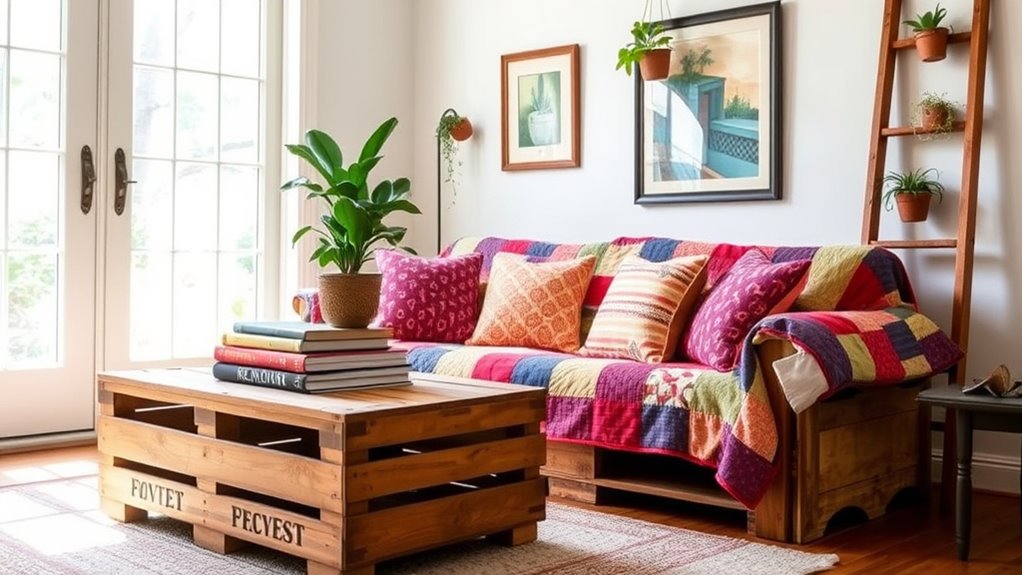
Look around your space for hidden treasures in closets, attics, or storage areas that can be refreshed. A fresh coat of paint or new hardware can transform old furniture into statement pieces. Mixing your repurposed items with new finds creates a unique, budget-friendly aesthetic. Incorporating vintage decor can further enhance the rustic charm without a hefty price tag. Additionally, being mindful of environmental impacts when selecting materials can help create a more sustainable and eco-friendly space. Exploring creative decoration techniques can also add personality and charm to your home while staying within your budget. Engaging with inspirational quotes about resourcefulness and innovation can motivate you to discover new ways to refresh your space. Regular checks on payment security measures when purchasing online can also help protect your investments in home decor.
Find Hidden Treasure Spots
You can often find hidden treasures right in your own home or at thrift shops, waiting to be repurposed or upcycled into stylish decor. Look beyond the obvious—an old ladder becomes a unique bookshelf, vintage crates transform into side tables, and mismatched cups can turn into charming planters. Check out attic corners, basements, and storage closets for overlooked items that could have new life. Flea markets and estate sales also hide affordable gems just waiting for your creative touch. Sometimes, all it takes is a fresh perspective to see potential in everyday objects. Recognizing the value of repurposing can help you make eco-friendly choices while enhancing your home’s style. Exploring creative reuse ideas can inspire you to find even more items to transform, especially when you understand the importance of fostering sustainability in home decor. Incorporating upcycling techniques can further elevate your DIY projects and give old items a modern twist. Additionally, understanding the impact of cookies on user experience can help you better manage online browsing while seeking inspiration for your projects.
Paint and Refresh Pieces
A fresh coat of paint can completely transform old furniture and decor, making them feel new without spending a fortune. Choose bold colors or trendy shades to add personality or neutral tones for versatility. You can also update pieces with new hardware or decorative details, giving them a fresh look. Upcycling is eco-friendly and budget-savvy. Consider these ideas:
| Item Type | Refresh Technique | Tip |
|---|---|---|
| Wooden chairs | Sand and repaint in vibrant hues | Add patterned cushions |
| Coffee tables | Apply a new stain or paint | Replace hardware for flair |
| Lampshades | Cover with fabric or paint | Use stencils for patterns |
| Picture frames | Spray paint or decoupage | Mix and match styles |
| Shelves | Repaint or add wallpaper accents | Create visual interest |
| Decorative accents | Incorporate recycled materials | Use items like pallets or vintage finds. Incorporating sustainable materials not only enhances your decor but also supports eco-friendly practices. You can also seek out upcycled decor options to further reduce waste and add unique charm to your space. Additionally, exploring angel numbers in your design choices can bring a sense of spiritual harmony and positive energy to your home. |
Combine Old and New
Transforming your space doesn’t have to mean buying new furniture. Instead, consider blending old and new pieces to create a fresh, personalized look. Upcycle a tired dresser by repainting it with a bold color or replacing hardware for a modern touch. Give vintage chairs a facelift with new upholstery or a coat of paint to match your decor. Mix sleek, contemporary tables with rustic accents to add character and depth. Repurpose items you already own—turn a ladder into a bookshelf or an old trunk into a storage ottoman. Incorporating signs of spoilage like mold or discoloration into your repurposing projects can help you avoid using damaged items. Understanding the importance of durability ensures that your projects will withstand daily use. Exploring sustainable practices can further enhance your eco-friendly approach to home decor. Considering self watering plant pots as part of your interior design can also add a practical, stylish touch that requires less maintenance. Additionally, selecting cost-effective materials and techniques allows you to achieve a high-end look without overspending. Combining different styles and eras not only saves money but also creates a layered, unique space that reflects your personality. Embrace creativity and make your home feel curated and vibrant without overspending.
Shop Smart With Thrift Stores and Sales
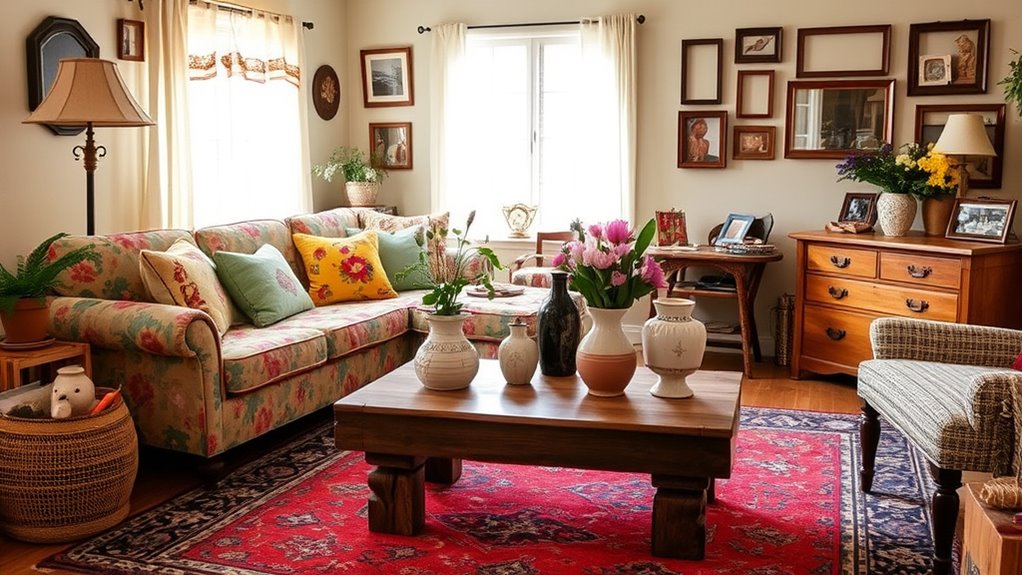
You can find unique pieces by hunting for hidden gems at thrift stores, saving money while adding character to your space. Keep an eye out for seasonal discounts, which let you score stylish items at a fraction of the price. Being strategic with your shopping helps you create a beautiful home without overspending. Additionally, shopping for oversized indoor plants at these venues can provide eye-catching focal points without exceeding your budget. For a touch of personality, consider exploring preppy dog names inspiration to add a playful yet sophisticated vibe to your decor.
Hunt for Hidden Gems
Ever wondered how to find unique furniture and decor without breaking the bank? The secret is hunting for hidden gems in thrift stores, flea markets, and clearance sales. These spots are goldmines for one-of-a-kind pieces that can instantly elevate your space. Keep an open mind and look beyond the obvious; you might discover a vintage armchair or a quirky lamp that fits your style perfectly. Bring a measuring tape so you can verify if pieces will fit in your home. Don’t rush—patience is key. Regularly visit different shops and keep an eye out for markdowns or special deals. With a little effort, you’ll find distinctive items that make your home truly yours—all without overspending.
Leverage Seasonal Discounts
Did you know that shopping during seasonal sales can considerably cut your interior design costs? Timing your purchases around these discounts allows you to snag stylish furniture, decor, and accessories at a fraction of the regular price. Keep an eye on holiday sales, end-of-season clearances, and store promotions. Many retailers offer deep discounts on items they need to clear out, giving you the perfect opportunity to find quality pieces for less. Visit thrift stores and outlet centers during these times, and don’t hesitate to negotiate or ask about upcoming sales. Planning your shopping trips around these discounts helps you stretch your budget further while still achieving a polished look. Being strategic with seasonal discounts empowers you to create an inviting space without overspending. Additionally, incorporating thrift shopping into your strategy can uncover unique and budget-friendly decor items that add character to your home. Recognizing the timing of sales can make all the difference in maximizing your savings and enhancing your interior design.
Use Paint to Transform Spaces
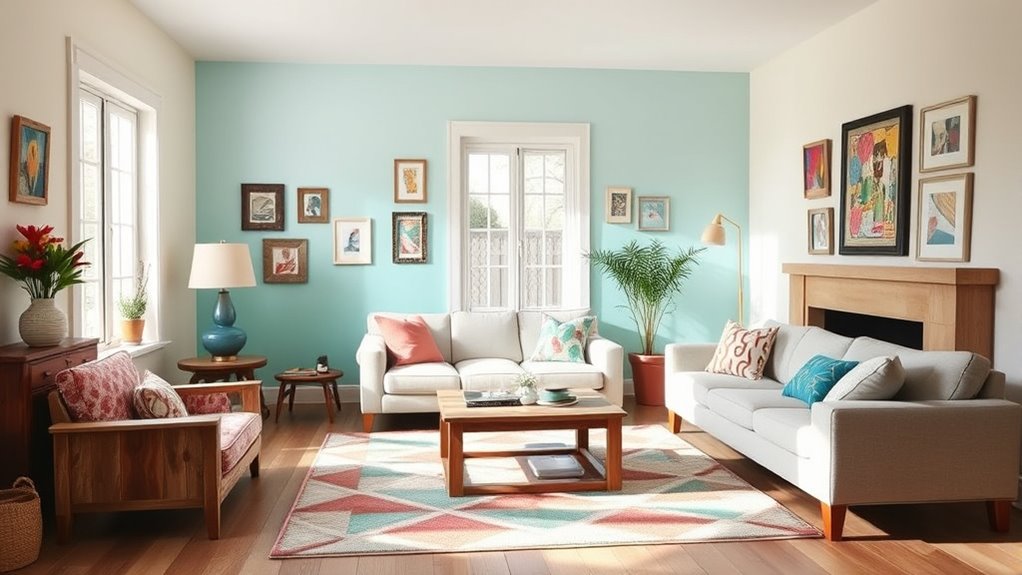
A fresh coat of paint can instantly redefine a room’s atmosphere without breaking the bank. Choosing the right color can make a space feel larger, cozier, brighter, or calmer. You don’t need to stick with traditional neutrals; bold colors or accent walls add personality without a hefty price tag. To save money, shop during sales or buy leftover paint cans from home improvement stores. You can also experiment with different finishes, like matte or semi-gloss, to create unique textures. Proper preparation, like cleaning and taping, guarantees a smooth finish. Even small areas, such as a single wall or furniture piece, can make a big impact. Paying attention to paint expiration dates can ensure the quality and longevity of your project. With a little effort, paint transforms your space into a fresh, inviting environment that reflects your style—all on a budget.
Incorporate DIY Decor Projects
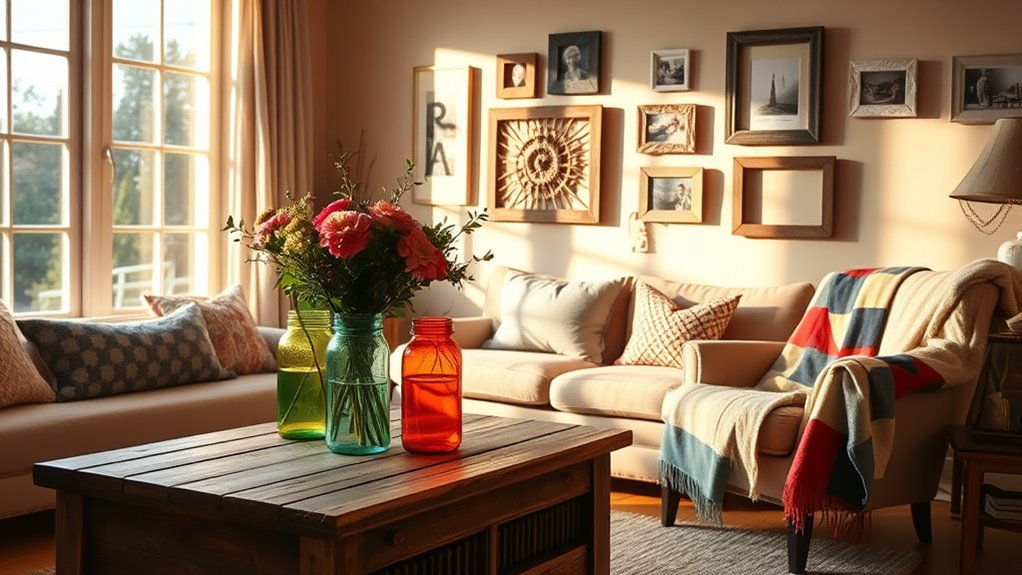
You can easily refresh your space with creative upcycling ideas that turn old items into new decor. Using affordable craft materials, you’ll find it’s simple to create personalized pieces without breaking the bank. DIY projects not only save money but also add a unique, handmade touch to your home.
Creative Upcycling Ideas
Upcycling offers a smart way to refresh your home without spending a fortune, turning everyday items into unique decor pieces. You can transform old jars into stylish vases or repurpose wooden pallets into coffee tables. Think creatively—an unused ladder becomes a bookshelf, or worn-out teacups become charming planters. To inspire you, here’s a quick guide:
| Item | Upcycling Idea | Result |
|---|---|---|
| Glass jars | Paint and add labels | Decorative storage |
| Wooden pallets | Sand and stain, add cushions | Rustic coffee table |
| Old T-shirts | Cut into rags or wall art | Practical or decorative |
| Tin cans | Paint and hang as planters | Indoor garden accents |
| Vintage suitcases | Stack or hang as side tables | Quirky storage or decor |
Get creative and give new life to old objects, saving money and adding personality.
Affordable Crafting Materials
Finding affordable crafting materials is key to bringing your DIY decor ideas to life without breaking the bank. You can find budget-friendly supplies at dollar stores, thrift shops, or online marketplaces. Repurpose items like old jars, pallets, or fabric scraps to create unique decor pieces. Look for sales and clearance sections to snag discounts on paints, brushes, and craft supplies. Using everyday items, such as leftover wallpaper or scrap wood, adds character without extra costs. Don’t overlook natural materials like stones, shells, or branches, which can enhance your projects effortlessly. With a little creativity and resourcefulness, you can craft stunning decor that fits your style and your budget, making your home feel personalized and inviting without overspending.
Focus on Lighting for Ambiance
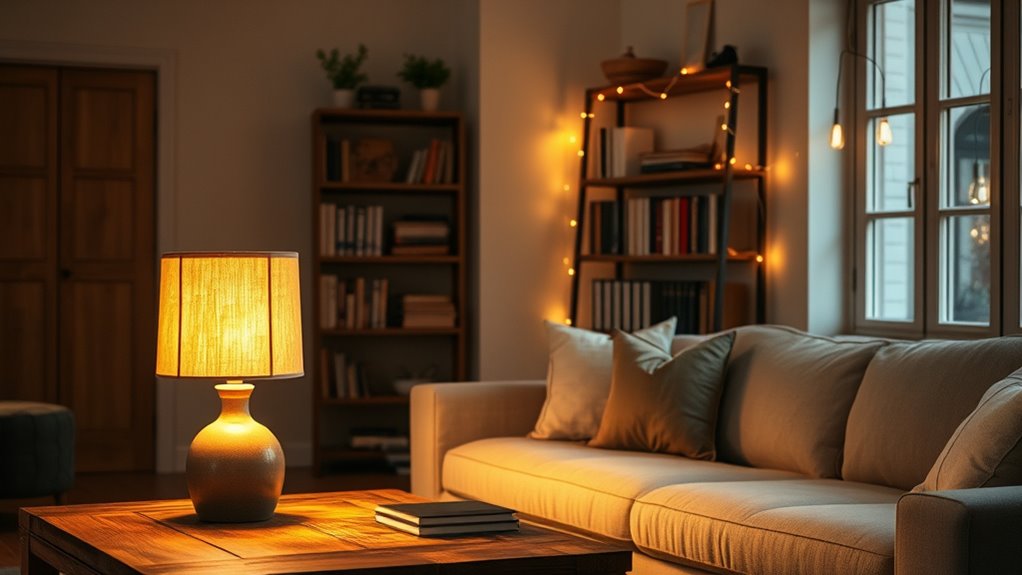
Lighting plays a crucial role in setting the mood of any space, and even on a tight budget, you can create a warm, inviting atmosphere by choosing the right fixtures and arrangements. Start by layering different types of lighting, such as ambient, task, and accent lights, to add depth and versatility. Use affordable options like string lights, battery-operated LED candles, or inexpensive floor and table lamps to enhance the ambiance. Adjust the brightness with dimmer switches or lower wattage bulbs to create a cozy feel. Position lights strategically to highlight key features or cozy corners. Don’t forget to utilize natural light during the day, opening curtains or blinds to brighten your space without extra cost. With thoughtful placement and affordable fixtures, your home can feel inviting and well-lit without breaking the bank.
Add Personal Touches With Accessories
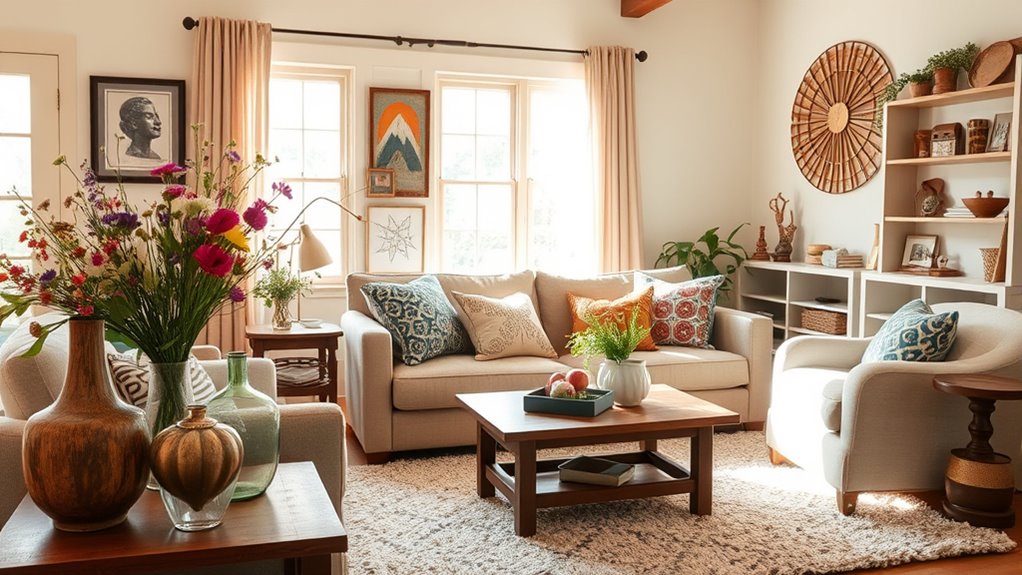
Adding personal touches with accessories is one of the easiest ways to make your space feel uniquely yours without overspending. Use items that reflect your personality, like framed photos, artwork, or souvenirs from your travels. Incorporate decorative pillows, throws, or rugs to add color and texture without a hefty price tag. Display meaningful objects on shelves or coffee tables to create a curated look. Plants are also affordable accessories that bring life and freshness to any room. Keep your accessories organized and intentional—too many can clutter your space. Remember, it’s about showcasing what matters most to you. Small changes, like swapping out a lampshade or adding a statement vase, can make a big impact on your home’s overall vibe.
Mix High and Low-End Finds
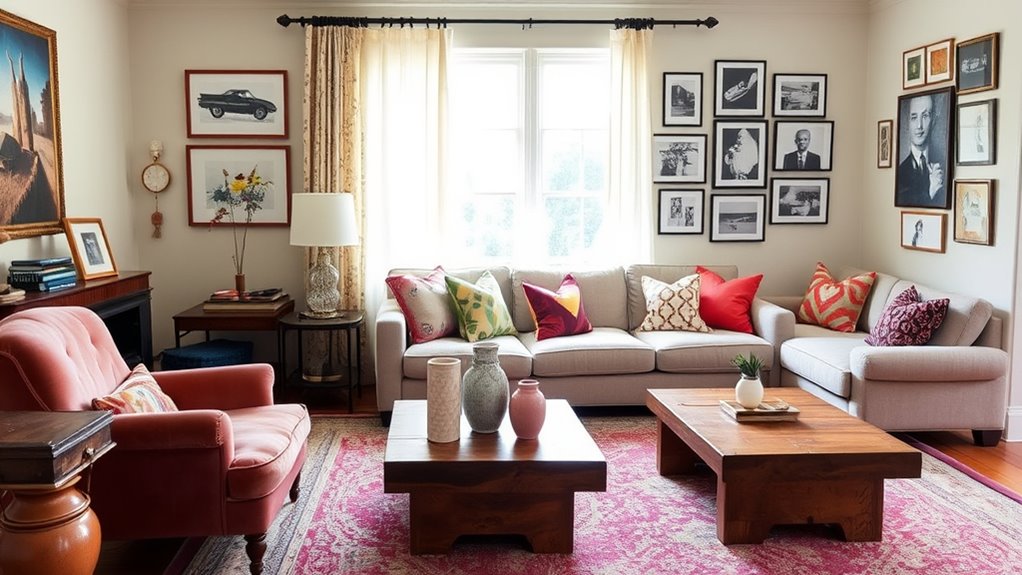
Blending high-end pieces with affordable finds can elevate your space without breaking the bank. Start by investing in a few key statement items, like a luxurious sofa or a striking piece of artwork. Complement these with budget-friendly accessories, such as stylish throw pillows or decorative vases. Mixing different price points creates visual interest and prevents your home from looking overly curated or uniform. Don’t be afraid to shop secondhand or at discount stores for quality pieces that look expensive. The goal is to strike a balance where each item enhances the overall aesthetic. With thoughtful pairing, you’ll achieve a sophisticated look that feels intentional and personalized—without overspending. Remember, it’s about combining your finds creatively, not about matching everything perfectly.
Create Cohesion With Color Schemes
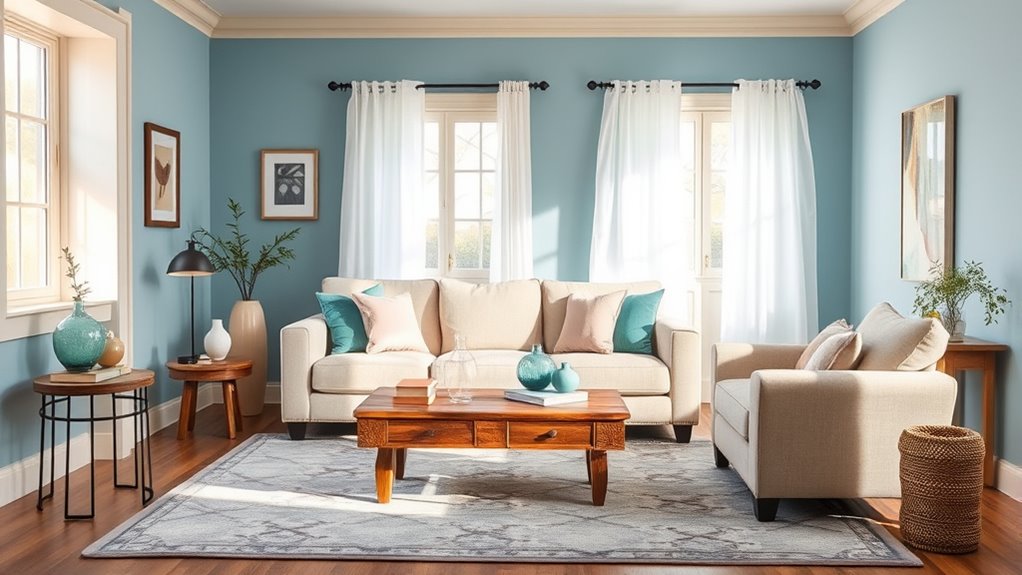
Creating a cohesive color scheme is essential for tying your space together and making it feel intentional. Start by choosing a neutral base color for walls and large furniture pieces, which provides flexibility and balance. Then, select two or three accent colors that complement each other and reflect your style. Use these colors consistently across accessories like pillows, rugs, artwork, and decor items. To keep costs low, repurpose or paint existing pieces in your chosen palette. Avoid mixing too many bold or clashing colors, as this can create visual chaos. Instead, stick to a harmonious palette that flows naturally throughout your space. This approach makes your home feel unified and thoughtfully designed without breaking the bank.
Plan and Budget Before Shopping
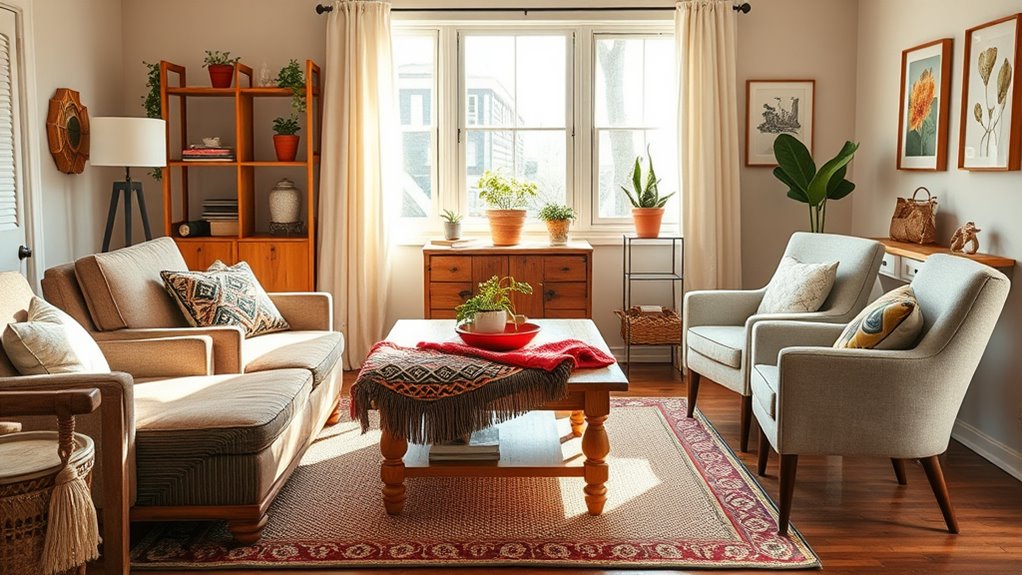
Before you start shopping for new decor, it’s important to plan your approach and set a realistic budget. Decide what items you need most and prioritize your spending. This helps prevent impulse buys and keeps you focused. To make your planning easier, consider creating a list of essentials and their estimated costs. Visualize your space with a mental picture of:
Start with a clear plan and budget to focus your decor shopping effectively.
- A cozy sofa that anchors your living room
- Elegant curtains that add privacy and style
- A functional dining table for family meals
- Decorative accents to personalize your space
Frequently Asked Questions
How Can I Make Small Spaces Look Larger on a Budget?
If you want small spaces to feel bigger, start by decluttering and choosing light colors to brighten the room. Use mirrors strategically to reflect light and create an illusion of depth. Opt for multi-functional furniture to save space and keep things organized. Keep window treatments simple and hang curtains high to make ceilings appear taller. These tips are budget-friendly and help your small space feel more open and inviting.
What Are the Best Budget-Friendly Materials for Durable Furniture?
You want durable furniture that doesn’t break the bank, so consider materials like solid wood, which offers longevity and timeless appeal, or high-quality laminate that mimics real wood at a lower cost. Reclaimed wood is eco-friendly and sturdy, while metal frames provide strength and a modern look. Look for options with good warranties or reviews, ensuring your investment lasts without overspending.
How Do I Choose a Cohesive Color Palette Without Overspending?
Imagine your home as a canvas waiting for a splash of harmony. To choose a cohesive color palette without overspending, start with three to four colors that complement each other—think soft neutrals, calming blues, or warm earth tones. Use paint samples or small decor pieces to test combinations. Stick to these hues across different rooms, creating a unified look that feels intentional and budget-friendly.
Can Budget Decor Items Look High-End With Proper Styling?
With the right styling, budget decor items can look high-end. You should focus on arranging pieces thoughtfully, mixing textures, and incorporating statement accessories. Use lighting to highlight key areas and keep the space uncluttered. Choosing a few quality pieces and pairing them with simpler items creates a sophisticated look. Remember, it’s all about presentation—proper styling can elevate affordable decor to look luxurious.
What Are Quick Tips for Maintaining a Stylish Home on a Tight Budget?
Imagine you’re a modern-day Marie Antoinette, even if your budget isn’t royal. To keep your home stylish on a tight budget, focus on decluttering regularly and swapping out accessories for a fresh look. Paint is your best friend—repainting furniture or walls adds instant flair. Use mirrors to create the illusion of space, and DIY art to personalize your space. Small changes make a big difference without breaking the bank.
Conclusion
Think of decorating your home like tending a garden—you don’t need every flower to be rare or expensive. Focus on key pieces, repurpose what you have, and add personal touches. I once transformed a dull living room with a fresh coat of paint and thrifted accessories, turning it into my favorite spot. With smart choices and a little creativity, you can craft a beautiful space without breaking the bank. Your dream home is within reach—start small and enjoy the journey!
